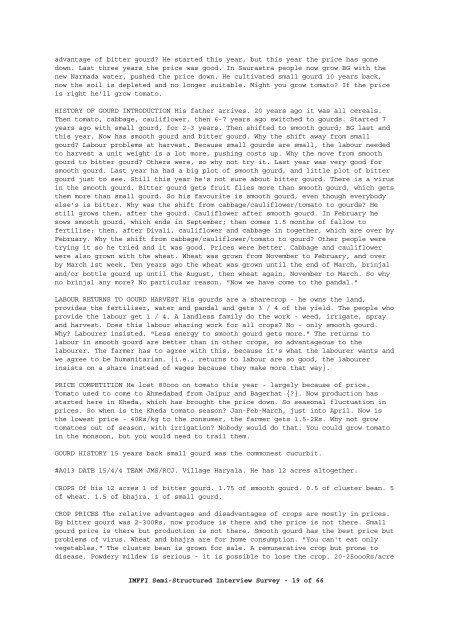“Key Informant Survey” of Production, Value, Losses and ... - DfID
“Key Informant Survey” of Production, Value, Losses and ... - DfID
“Key Informant Survey” of Production, Value, Losses and ... - DfID
You also want an ePaper? Increase the reach of your titles
YUMPU automatically turns print PDFs into web optimized ePapers that Google loves.
advantage <strong>of</strong> bitter gourd? He started this year, but this year the price has gone<br />
down. Last three years the price was good. In Saurastra people now grow BG with the<br />
new Narmada water, pushed the price down. He cultivated small gourd 10 years back,<br />
now the soil is depleted <strong>and</strong> no longer suitable. Might you grow tomato? If the price<br />
is right he'll grow tomato.<br />
HISTORY OF GOURD INTRODUCTION His father arrives. 20 years ago it was all cereals.<br />
Then tomato, cabbage, cauliflower, then 6-7 years ago switched to gourds. Started 7<br />
years ago with small gourd, for 2-3 years. Then shifted to smooth gourd; BG last <strong>and</strong><br />
this year. Now has smooth gourd <strong>and</strong> bitter gourd. Why the shift away from small<br />
gourd? Labour problems at harvest. Because small gourds are small, the labour needed<br />
to harvest a unit weight is a lot more, pushing costs up. Why the move from smooth<br />
gourd to bitter gourd? Others were, so why not try it. Last year was very good for<br />
smooth gourd. Last year ha had a big plot <strong>of</strong> smooth gourd, <strong>and</strong> little plot <strong>of</strong> bitter<br />
gourd just to see. Still this year he's not sure about bitter gourd. There is a virus<br />
in the smooth gourd. Bitter gourd gets fruit flies more than smooth gourd, which gets<br />
them more than small gourd. So his favourite is smooth gourd, even though everybody<br />
else's is bitter. Why was the shift from cabbage/cauliflower/tomato to gourds? He<br />
still grows them, after the gourd. Cauliflower after smooth gourd. In February he<br />
sows smooth gourd, which ends in September; then comes 1.5 months <strong>of</strong> fallow to<br />
fertilise; then, after Divali, cauliflower <strong>and</strong> cabbage in together, which are over by<br />
February. Why the shift from cabbage/cauliflower/tomato to gourd? Other people were<br />
trying it so he tried <strong>and</strong> it was good. Prices were better. Cabbage <strong>and</strong> cauliflower<br />
were also grown with the wheat. Wheat was grown from November to February, <strong>and</strong> over<br />
by March 1st week. Ten years ago the wheat was grown until the end <strong>of</strong> March, brinjal<br />
<strong>and</strong>/or bottle gourd up until the August, then wheat again, November to March. So why<br />
no brinjal any more? No particular reason. "Now we have come to the p<strong>and</strong>al."<br />
LABOUR RETURNS TO GOURD HARVEST His gourds are a sharecrop - he owns the l<strong>and</strong>,<br />
provides the fertiliser, water <strong>and</strong> p<strong>and</strong>al <strong>and</strong> gets 3 / 4 <strong>of</strong> the yield. The people who<br />
provide the labour get 1 / 4. A l<strong>and</strong>less family do the work - weed, irrigate, spray<br />
<strong>and</strong> harvest. Does this labour sharing work for all crops? No - only smooth gourd.<br />
Why? Labourer insisted. "Less energy to smooth gourd gets more." The returns to<br />
labour in smooth gourd are better than in other crops, so advantageous to the<br />
labourer. The farmer has to agree with this, because it's what the labourer wants <strong>and</strong><br />
we agree to be humanitarian. {i.e., returns to labour are so good, the labourer<br />
insists on a share instead <strong>of</strong> wages because they make more that way}.<br />
PRICE COMPETITION He lost 80ooo on tomato this year - largely because <strong>of</strong> price.<br />
Tomato used to come to Ahmedabad from Jaipur <strong>and</strong> Bagerhat {?}. Now production has<br />
started here in Kheda, which has brought the price down. So seasonal fluctuation in<br />
prices. So when is the Kheda tomato season? Jan-Feb-March, just into April. Now is<br />
the lowest price - 40Rs/kg to the consumer, the farmer gets 1.5-2Rs. Why not grow<br />
tomatoes out <strong>of</strong> season, with irrigation? Nobody would do that. You could grow tomato<br />
in the monsoon, but you would need to trail them.<br />
GOURD HISTORY 15 years back small gourd was the commonest cucurbit.<br />
#A013 DATE 15/4/4 TEAM JMS/RCJ. Village Haryala. He has 12 acres altogether.<br />
CROPS Of his 12 acres 1 <strong>of</strong> bitter gourd. 1.75 <strong>of</strong> smooth gourd. 0.5 <strong>of</strong> cluster bean. 5<br />
<strong>of</strong> wheat. 1.5 <strong>of</strong> bhajra. 1 <strong>of</strong> small gourd.<br />
CROP PRICES The relative advantages <strong>and</strong> disadvantages <strong>of</strong> crops are mostly in prices.<br />
Eg bitter gourd was 2-300Rs, now produce is there <strong>and</strong> the price is not there. Small<br />
gourd price is there but production is not there. Smooth gourd has the best price but<br />
problems <strong>of</strong> virus. Wheat <strong>and</strong> bhajra are for home consumption. "You can't eat only<br />
vegetables." The cluster bean is grown for sale. A remunerative crop but prone to<br />
disease. Powdery mildew is serious - it is possible to lose the crop. 20-25oooRs/acre<br />
IMFFI Semi-Structured Interview Survey - 19 <strong>of</strong> 66

















